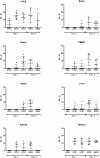Systemic distribution of different low pathogenic avian influenza (LPAI) viruses in chicken
- PMID: 23324567
- PMCID: PMC3552765
- DOI: 10.1186/1743-422X-10-23
Systemic distribution of different low pathogenic avian influenza (LPAI) viruses in chicken
Abstract
Background: Since we were able to isolate viable virus from brain and lung of H7N1 low pathogenic avian influenza virus (LPAIV) infected chickens, we here examined the distribution of different LPAIV strains in chickens by measuring the viral AI RNA load in multiple organs. Subtypes of H5 (H5N1, H5N2), H7 (H7N1, H7N7) and H9 (H9N2), of chicken (H5N2, H7N1, H7N7, H9N2), or mallard (H5N1) origin were tested. The actual presence of viable virus was evaluated with virus isolation in organs of H7N7 inoculated chickens.
Findings: Viral RNA was found by PCR in lung, brain, intestine, peripheral blood mononuclear cells, heart, liver, kidney and spleen from chickens infected with chicken isolated LPAIV H5N2, H7N1, H7N7 or H9N2. H7N7 virus could be isolated from lung, ileum, heart, liver, kidney and spleen, but not from brain, which was in agreement with the data from the PCR. Infection with mallard isolated H5N1 LPAIV resulted in viral RNA detection in lung and peripheral blood mononuclear cells only.
Conclusion: We speculate that chicken isolated LPAI viruses are spreading systemically in chicken, independently of the strain.
Figures



Similar articles
-
Avian influenza surveillance reveals presence of low pathogenic avian influenza viruses in poultry during 2009-2011 in the West Bengal State, India.Virol J. 2012 Aug 7;9:151. doi: 10.1186/1743-422X-9-151. Virol J. 2012. PMID: 22867041 Free PMC article.
-
Systemic virus distribution and host responses in brain and intestine of chickens infected with low pathogenic or high pathogenic avian influenza virus.Virol J. 2012 Mar 6;9:61. doi: 10.1186/1743-422X-9-61. Virol J. 2012. PMID: 22390870 Free PMC article.
-
Proteins of duck influenza virus responsible for acquisition of pathogenicity in chickens.Virus Res. 2013 May;173(2):294-8. doi: 10.1016/j.virusres.2013.02.001. Epub 2013 Feb 19. Virus Res. 2013. PMID: 23434880
-
Highly pathogenic avian influenza viruses with low virulence for chickens in in vivo tests.Avian Pathol. 2007 Oct;36(5):347-50. doi: 10.1080/03079450701589134. Avian Pathol. 2007. PMID: 17899457 Review.
-
Challenge for One Health: Co-Circulation of Zoonotic H5N1 and H9N2 Avian Influenza Viruses in Egypt.Viruses. 2018 Mar 9;10(3):121. doi: 10.3390/v10030121. Viruses. 2018. PMID: 29522492 Free PMC article. Review.
Cited by
-
Dickkopf-1 has an Inhibitory Effect on Mesenchymal Stem Cells to Fibroblast Differentiation.Chin Med J (Engl). 2016 May 20;129(10):1200-7. doi: 10.4103/0366-6999.181974. Chin Med J (Engl). 2016. PMID: 27174329 Free PMC article.
-
Sequence characteristics and phylogenetic analysis of H9N2 subtype avian influenza A viruses detected from poultry and the environment in China, 2018.PeerJ. 2021 Dec 20;9:e12512. doi: 10.7717/peerj.12512. eCollection 2021. PeerJ. 2021. PMID: 35036116 Free PMC article.
-
Assessment of listing and categorisation of animal diseases within the framework of the Animal Health Law (Regulation (EU) No 2016/429): low pathogenic avian influenza.EFSA J. 2017 Jul 21;15(7):e04891. doi: 10.2903/j.efsa.2017.4891. eCollection 2017 Jul. EFSA J. 2017. PMID: 32625556 Free PMC article.
-
Non-basic amino acids in the hemagglutinin proteolytic cleavage site of a European H9N2 avian influenza virus modulate virulence in turkeys.Sci Rep. 2020 Dec 4;10(1):21226. doi: 10.1038/s41598-020-78210-8. Sci Rep. 2020. PMID: 33277593 Free PMC article.
-
The Evolution, Spread and Global Threat of H6Nx Avian Influenza Viruses.Viruses. 2020 Jun 22;12(6):673. doi: 10.3390/v12060673. Viruses. 2020. PMID: 32580412 Free PMC article. Review.
References
-
- Kwon J, Lee H, Lee D, Lee Y, Mo I, Nahm S, Kim M, Lee J, Park S, Choi I, Song C. Immune responses and pathogenesis in immunocompromised chickens in response to infection with the H9N2 low pathogenic avian influenza virus. Virus Res. 2008;133:187–194. doi: 10.1016/j.virusres.2007.12.019. - DOI - PubMed
Publication types
MeSH terms
LinkOut - more resources
Full Text Sources
Other Literature Sources
Medical

